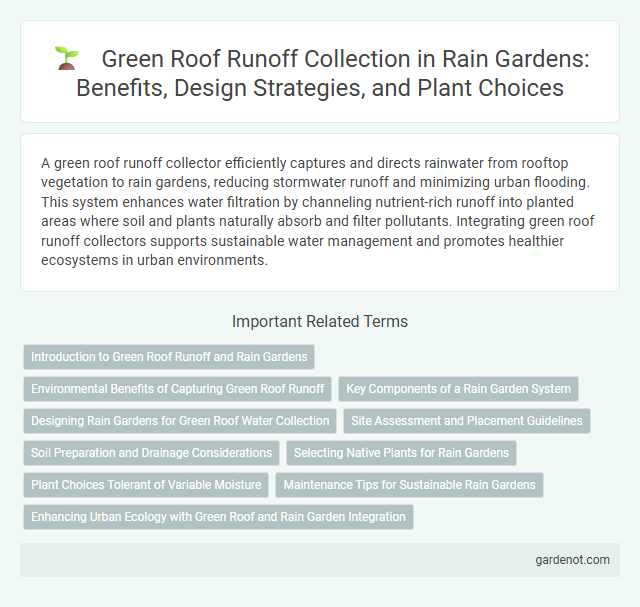A green roof runoff collector efficiently captures and directs rainwater from rooftop vegetation to rain gardens, reducing stormwater runoff and minimizing urban flooding. This system enhances water filtration by channeling nutrient-rich runoff into planted areas where soil and plants naturally absorb and filter pollutants. Integrating green roof runoff collectors supports sustainable water management and promotes healthier ecosystems in urban environments.
Introduction to Green Roof Runoff and Rain Gardens
Green roof runoff significantly contributes to urban stormwater, carrying pollutants and increasing peak flow rates that can overwhelm traditional drainage systems. Rain gardens are strategically designed to capture and filter this runoff, using native plants and engineered soil media to enhance infiltration and reduce contaminants. Integrating green roof runoff collectors with rain gardens optimizes stormwater management by intercepting water at its source and promoting natural absorption processes.
Environmental Benefits of Capturing Green Roof Runoff
Green roof runoff collectors play a crucial role in managing stormwater by capturing and filtering rainwater before it enters municipal drainage systems, reducing the risk of flooding and erosion. This process helps improve water quality by trapping pollutants, heavy metals, and sediments, thereby protecting local waterways and aquatic ecosystems. By retaining and slowly releasing runoff, green roof collectors also enhance groundwater recharge and mitigate urban heat island effects, promoting overall environmental sustainability.
Key Components of a Rain Garden System
A Green roof runoff collector integrates key components such as an engineered soil mix, a drainage layer, and native plant species specifically chosen for their infiltration and pollutant absorption capabilities. These elements work together to capture, filter, and slowly release rainwater, reducing stormwater runoff volume and improving water quality. Proper design includes a berm or overflow outlet to manage excess water and protect the surrounding landscape from erosion.
Designing Rain Gardens for Green Roof Water Collection
Designing rain gardens for green roof water collection maximizes stormwater management by capturing and filtering runoff from impervious surfaces. Incorporating permeable soil layers, native vegetation, and strategic placement ensures optimal absorption and retention of green roof runoff, reducing urban flooding and enhancing groundwater recharge. Effective rain garden designs integrate smart overflow systems and sediment traps to maintain water quality and support sustainable urban ecosystems.
Site Assessment and Placement Guidelines
Site assessment for green roof runoff collectors involves analyzing roof slope, drainage patterns, and structural load capacity to ensure optimal placement and performance. Placement guidelines recommend positioning collectors near downspouts and low points to maximize water capture while considering accessibility for maintenance. Integrating soil media and vegetation characteristics enhances runoff absorption and filtration efficiency within the rain garden system.
Soil Preparation and Drainage Considerations
Soil preparation for green roof runoff collectors in rain gardens requires a well-structured medium with high permeability to ensure efficient drainage and prevent waterlogging. Incorporating layers of sandy loam mixed with organic compost enhances water retention while facilitating rapid drainage, crucial for managing runoff. Properly graded substrate and installation of a drainage mat or layer beneath the soil further improve water flow control, reducing the risk of root rot and structural damage.
Selecting Native Plants for Rain Gardens
Selecting native plants for rain gardens enhances the green roof runoff collector's ability to filter pollutants and manage stormwater effectively. Native species like Echinacea purpurea, Asclepias tuberosa, and Juncus effusus adapt well to local climate conditions, promoting a resilient ecosystem while minimizing maintenance. Integrating these plants improves soil infiltration rates and supports biodiversity, making rain gardens an efficient solution for sustainable water management.
Plant Choices Tolerant of Variable Moisture
Green roof runoff collectors benefit from plant choices tolerant of variable moisture, such as sedums, ferns, and native grasses that adapt to fluctuating wet and dry conditions. These species enhance water retention and filtration efficiency by thriving in the diverse moisture levels typical of runoff collection systems. Selecting drought-resistant yet moisture-flexible plants supports the overall sustainability and functionality of green roof rain gardens.
Maintenance Tips for Sustainable Rain Gardens
Regular inspection and cleaning of the green roof runoff collector prevent debris buildup, ensuring efficient water flow into the rain garden. Seasonal maintenance involves checking for blockages and repairing any damage to maintain optimal filtration and prevent erosion. Integrating native plants with deep roots around the collector enhances soil stability and supports sustainable water management.
Enhancing Urban Ecology with Green Roof and Rain Garden Integration
Green roof runoff collectors efficiently capture and channel rainwater into rain gardens, reducing stormwater runoff and mitigating urban flooding. Integrating green roofs with rain gardens enhances urban ecology by promoting biodiversity, improving air quality, and creating habitats for pollinators and birds. This synergy supports sustainable water management and fosters resilient urban landscapes.
Green roof runoff collector Infographic

 gardenot.com
gardenot.com